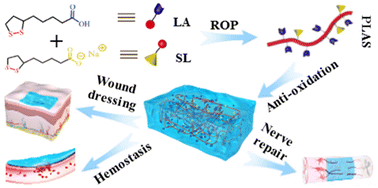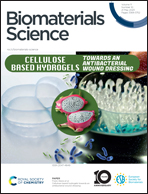Green polymer hydrogels from a natural monomer with inherent antioxidative capability for efficient wound healing and spinal cord injury treatment†
Abstract
Development of polymeric hydrogels with multiple functions (adhesiveness, self-healability, anti-oxidation efficiency, etc.) through one-step green polymerization of naturally occurring small molecules in water is critical for various biomedical applications and clinical transformation. In this work, benefiting from the dynamic disulfide bond in α-lipoic acid (LA), we directly obtain an advanced hydrogel (poly(lipoic acid-co-sodium lipoate) (PLAS)) through heat and concentration-induced ring-opening polymerization of LA with the addition of NaHCO3 in an aqueous solution. The presence of COOH, COO− and disulfide bonds endows the resulting hydrogels with comprehensive mechanical properties, facile injectability, fast self-healability and adequate adhesiveness. Moreover, the PLAS hydrogels show promising antioxidative efficiency, inherited from naturally occurring LA, and can efficiently eliminate intracellular reactive oxygen species (ROS). We also verify the advantage of PLAS hydrogels in a rat spinal injury model. Through the regulation of ROS and in situ inflammation, our system can promote the recovery of spinal cord injury. Owing to the natural origin and inherent anti-oxidative capability of LA, and a green preparation method, our hydrogel should be beneficial for clinical transformation and may be a good candidate for various biomedical applications.



 Please wait while we load your content...
Please wait while we load your content...